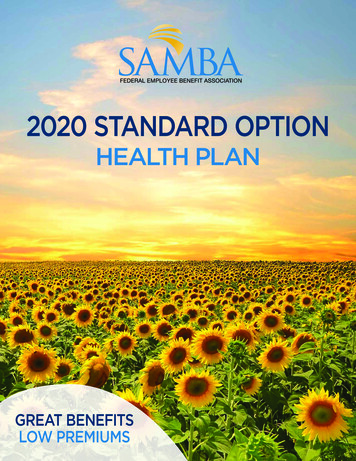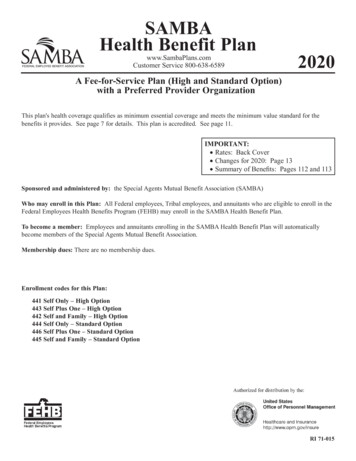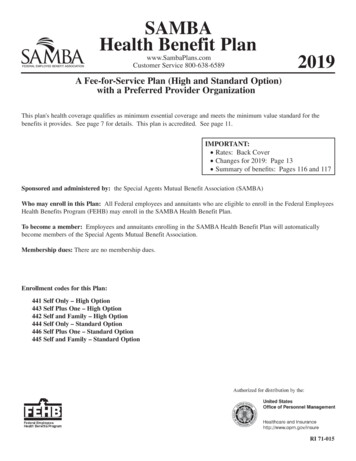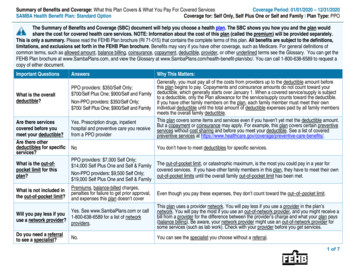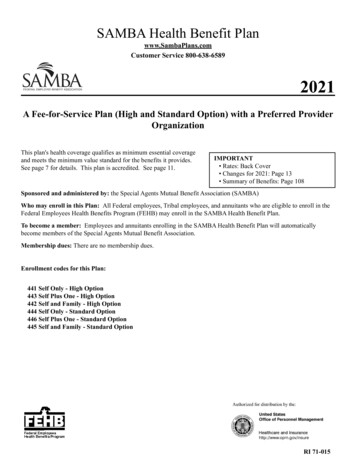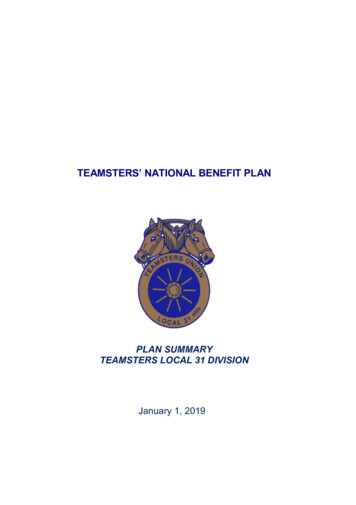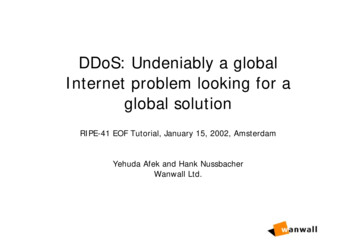
Transcription
SAMBAHealth Benefit Planhttp://www.samba-insurance.com2001A fee-for-service planwith a preferred provider organizationSponsored and administered by: the Special Agents Mutual Benefit AssociationWho may enroll in this Plan: Active employees of the Federal Bureau of Investigation(FBI), the Drug Enforcement Administration (DEA), the Bureau of Alcohol, Tobacco, andFirearms (BATF), the Naval Investigative Service (NIS), the United States Marshals Service(USMS), the Department of Justice Office of the Inspector General (IG), the CriminalInvestigation Division and the National Treasury Inspector General for Tax Administration(IRS), Civilian Employees of the Office of Special Investigations of the Department of theAir Force (OSI), the Executive Office of the United States Attorneys (EOUSA), the Offices,Boards and Divisions of the Department of Justice (OBD), the United States CustomsService (USCS), the Financial Crimes Enforcement Network (FinCEN) and allpresidentially-appointed offices of the Inspectors General (IGs).The only annuitants who may enroll in this Plan are persons who retired from the DEA onor after January 9, 1983, who retired from the BATF or the NIS on or after January 5, 1986,who retired from the USMS or the Department of Justice IG on or after January 14, 1990,who retired from the National Treasury IG on or after January 12, 1992, who retired fromthe OSI on or after January 10, 1993, who retired from the EOUSA or the OBD on or afterJanuary 8, 1995, who retired from the USCS or the FinCEN on or after January 4, 1998,who will retire from the presidentially-appointed offices of the IG on or after January 14,2001, and all retired employees of the FBI.Membership dues: There are no membership dues.Enrollment codes for this Plan:441 Self Only442 Self and FamilyRI 72-006
Table of ContentsIntroduction . 4Plain Language . 4Section 1. Facts about this fee-for-service plan . 5Section 2. How we change for 2001 . 6Section 3. How you get care . . 7Identification cards . 7Where you get covered care. 7 Covered providers. 8 Covered facilities . 8What you must do to get covered care. 9How to get approval for . 10 Your hospital stay (precertification) . 10 Other services . 12Section 4. Your costs for covered services . 13 Copayments . 13 Deductible. 13 Coinsurance . 13 Differences between our allowance and the bill . 14Your out-of-pocket maximum . 15When government facilities bill us . 15If we overpay you . 15When you are age 65 or over and you do not have Medicare. 16When you have Medicare . 17Section 5. Benefits . 18Overview. 18(a) Medical services and supplies provided by physicians and other health care professionals. 19(b) Surgical and anesthesia services provided by physicians and other health care professionals . 27(c) Services provided by a hospital or other facility, and ambulance services . 33(d) Emergency services/accidents . 37(e) Mental health and substance abuse benefits . 38(f) Prescription drug benefits . 43(g) Special features. 47(h) Dental benefits . 49(i) Non-FEHB benefits available to Plan members . 51Section 6. General exclusions – things we don't cover . 52Section 7. Filing a claim for covered services . 542001 SAMBA2Table of Contents
Section 8. The disputed claims process.56Section 9. Coordinating benefits with other coverage .58When you have other health coverage .58Original Medicare .58Medicare managed care plan.61TRICARE/Workers Compensation/Medicaid.61When other Government agencies are responsible for your care .62When others are responsible for injuries.62Section 10. Definitions of terms we use in this brochure.63Section 11. FEHB facts.66Coverage information.66 No pre-existing condition limitation .66 Where you get information about enrolling in the FEHB Program .66 Types of coverage available for you and your family.66 When benefits and premiums start.66 Your medical and claims records are confidential.67 When you retire .67When you lose benefits .67 When FEHB coverage ends .67 Spouse equity coverage.67 Temporary Continuation of Coverage (TCC) .67 Converting to individual coverage .68 Getting a Certificate of Group Health Plan Coverage.68Inspector General Advisory.68INDEX .69Summary of benefits .71Rates.Back cover2001 SAMBA3Table of Contents
IntroductionSAMBA Health Benefit Plan11301 Old Georgetown RoadRockville, MD 20852-2800This brochure describes the benefits of the SAMBA Health Benefit Plan under our contract (CS 1074) with the Officeof Personnel Management (OPM), as authorized by the Federal Employees Health Benefits law. This brochure is theofficial statement of benefits. No oral statement can modify or otherwise affect the benefits, limitations, and exclusionsof this brochure.If you are enrolled in this Plan, you are entitled to the benefits described in this brochure. If you are enrolled for Selfand Family coverage, each eligible family member is also entitled to these benefits. You do not have a right to benefitsthat were available before January 1, 2001, unless those benefits are also shown in this brochure.OPM negotiates benefits and rates with each plan annually. Benefit changes are effective January 1, 2001, and aresummarized on page 6. Rates are shown at the end of this brochure.Plain LanguageThe President and Vice President are making the Government’s communication more responsive, accessible, andunderstandable to the public by requiring agencies to use plain language. In response, a team of health planrepresentatives and OPM staff worked cooperatively to make this brochure clearer. Except for necessary technicalterms, we use common words. “You” means the enrollee or family member; "we" means the SAMBA Health BenefitPlan.The plain language team reorganized the brochure and the way we describe our benefits. When you compare this Planwith other FEHB plans, you will find that the brochures have the same format and similar information to makecomparisons easier.If you have comments or suggestions about how to improve this brochure, let us know. Visit OPM's "Rate Us"feedback area at www.opm.gov/insure or e-mail us at fehbwebcomments@opm.gov or write to OPM at InsurancePlanning and Evaluation Division, P.O. Box 436, Washington, DC 20044-0436.2001 SAMBA4Introduction/Plain Language
Section 1. Facts about this fee-for-service planThis Plan is a fee-for-service (FFS) plan. You can choose your own physicians, hospitals, and other health careproviders.We reimburse you or your provider for your covered services, usually based on a percentage of the amount we allow.The type and extent of covered services, and the amount we allow, may be different from other plans. Read brochurescarefully.We also have Preferred Provider Organizations (PPO):Our fee-for-service plan offers services through a PPO. When you use our PPO providers, you will receive coveredservices at reduced cost. Contact us for the names of PPO providers and to verify their continued participation. You canalso go to our web page, which you can reach through the FEHB web site, www.opm.gov/insure. Do not call OPM oryour agency for our provider directory.PPO benefits apply only when you use a PPO provider. Provider networks may be more extensive in some areas thanothers. We cannot guarantee the availability of every specialty in all areas. If no PPO provider is available, or you donot use a PPO provider, the standard non-PPO benefits apply.How we pay providersWhen you use a PPO provider or facility, our Plan allowance is the negotiated rate for the service. You are notresponsible for charges above the negotiated amount.Non-PPO facilities and providers do not have special agreements with the Plan. Our payment is based on the Planallowance for covered services. You may be responsible for amounts over the allowance.We also obtain discounts from some non-PPO providers. When we obtain discounts through negotiations withproviders (PPO or non-PPO), we pass along the savings to you.Patients’ Bill of RightsOPM requires that all FEHB Plans comply with the Patients’ Bill of Rights, recommended by the President’s AdvisoryCommission on Consumer Protection and Quality in the Health Care Industry. You may get information about us, ournetworks, providers, and facilities. OPM’s FEHB website (www.opm.gov/insure) lists the specific types of informationthat we must make available to you. Some of the required information is listed below. SAMBA was established in 1948SAMBA is a non-profit employee associationIf you want more information about us, call 1-800/638-6589 or 301/984-1440 (for TDD, use 301/984-4155), or write toSAMBA 11301 Old Georgetown Road, Rockville, MD 20852-2800. You may also contact us by fax at 301/984-6224or visit our website at www.samba-insurance.com.2001 SAMBA5Section 1
Section 2. How we change for 2001Program-wide changes The plain language team reorganized the brochure and the way we describe our benefits. We hope this will make iteasier for you to compare plans. This year, the Federal Employees Health Benefits Program is implementing network mental health and substanceabuse parity. This means that your coverage for mental health, substance abuse, medical, surgical, and hospitalservices from providers in our PPO network will be the same with regard to deductibles, coinsurance, copays, andday and visit limitations when you follow a treatment plan that we approve. SAMBA implemented this change incontract year 2000. Many healthcare organizations have turned their attention this past year to improving healthcare quality and patientsafety. OPM asked all FEHB plans to join them in this effort. You can find specific information on our patientsafety activities by calling SAMBA at 1-800/638-6589 or 301/984-1440 (for TDD, use 301/984-4155), or checkingour website, www.samba-insurance.com. You can find out more about patient safety on the OPM website,www.opm.gov/insure. To improve your healthcare, take these five steps: Speak up if you have questions or concerns.Keep a list of all the medications you take.Make sure you get the results of any test or procedure.Talk with your doctor and health care team about your options if you need hospital care.Make sure you understand what will happen if you need surgery. We clarified the language to show that anyone who needs a mastectomy may choose to have the procedureperformed on an inpatient basis and remain in the hospital up to 48 hours after the procedure. Previously, thelanguage referenced only women. North Dakota is deleted from the list of states designated as medically underserved in 2001. See page 8 forinformation on medically underserved areas.Changes to this Plan SAMBA has contracted with Worldwide Assistance Services, Inc. to provide medical assistance, medicalevacuation and other covered services to our members and their eligible family members through the WorldwideAssistance Program. Refer to separate brochure for a detailed description of this program. The Plan has contracted with the Pequot Pharmaceutical Network (PRxN), which will be the SAMBA PrescriptionDrug Program vendor for the retail pharmacy (through PCS Health Systems, Inc.) and mail order programs.Previously, PAID Prescriptions, Inc. and Merck-Medco Rx Services provided these services. The name brand single source (no generic equivalent) prescription drug copayment has increased from 15 to 20.Previously, if a generic equivalent was not available, you paid 15. The Plan’s reasonable and customary fee schedule is now referred to as the “Plan allowance.” In addition, for outof-network services, the Plan’s allowance is now based on the average PPO negotiated rate when you do not use aPPO network provider in areas where one is available. Under Mental Health and Substance Abuse Benefits a separate 300 per person per calendar year deductible hasbeen added – except for in-network office visits, where you continue to pay a 15 copayment. The deductible isapplied toward your catastrophic protection out-of-pocket maximums. The catastrophic protection limit has been increased from 1,500 to 2,500 for one person and from 2,000 to 3,500 for a family. Open enrollment in the SAMBA Health Benefit Plan has been extended to include the offices of all presidentiallyappointed Inspectors General (IGs). Your share of the SAMBA premium will increase by 23.9% for Self Only or 20.6% for Self and Family.2001 SAMBA6Section 2
Section 3. How you get careIdentification cardsWe will send you an identification (ID) card when you enroll. You shouldcarry your ID card with you at all times. You must show it whenever youreceive services from a Plan provider, or fill a prescription at a Planpharmacy. Until you receive your ID card, use your copy of the HealthBenefits Election Form, SF-2809, your health benefits enrollmentconfirmation (for annuitants), or your Employee Express confirmationletter.If you do not receive your ID card within 30 days after the effectivedate of your enrollment, or if you need replacement cards, call us at1-800/638-6589 or 301/984-1440 (for TDD, use 301/984-4155).Where you get covered care This Plan’s PPOsYou can get care from any “covered provider” or “covered facility.” Howmuch we pay – and you pay – depends on the type of covered provider orfacility you use. If you use our preferred providers, you will pay less.We have entered into arrangements (geographically) with CareFirstBlueCross BlueShield (CareFirst) and First Health Group Corp. (FirstHealth) to offer Preferred Provider Organization (PPO) Networks toSAMBA enrollees. See below to determine which PPO Network servicesyour area. Enrollees who reside in the Washington, DC Metropolitan area,including the District of Columbia, the Maryland counties of Calvert,Charles, Frederick, Montgomery, Prince George’s and St. Mary’s, theVirginia counties of Arlington, Fairfax, Loudoun, Prince William,Spotsylvania, and Stafford, and the cities of Alexandria, Fairfax, FallsChurch, and Fredericksburg and those in the Baltimore Metropolitanarea including the city of Baltimore, and the Maryland counties ofAnne Arundel, Baltimore, Carroll, Harford, and Howard may utilizethe CareFirst PPO Network. Call CareFirst customer service toll-free,1-877/691-5856, for information concerning the PPO. Enrollees outside the CareFirst service areas (listed above) may utilizethe First Health PPO Network. Call First Health’s ReferralManagement/Telephonic Provider Directory at 1-800/346-6755 toconfirm provider participation and identify Network providers. Managed Care Advisor (MCA) Program — Enrollees in the FirstHealth service areas lacking Network access (as determined by thePlan) may join the Plan’s Managed Care Advisor (MCA) Program.Refer to Section 5(g) on page 47 for additional information.PPO benefits apply only when you use a PPO provider. Provider networksmay be more extensive in some areas than others. The availability of everyspecialty in all areas cannot be guaranteed. If no PPO provider is availablethe standard non-PPO benefits apply.2001 SAMBA7Section 3
Note: Use of a participating Network doctor or hospital does not guaranteethat the associated ancillary providers such as specialists, emergency roomdoctors, anesthesiologists, radiologists, and pathologists participate in theNetwork. Subject to the Plan’s definitions, limitations and exclusions, thePlan pays its PPO benefits as outlined in this brochure when services areprovided by a doctor or other provider participating in the Plan’s PPONetwork. If you use a non-PPO provider, the standard non-PPO benefitswill apply as outlined in this brochure. When you phone for anappointment, please remember to verify that the physician or facility is stilla PPO Network provider. Covered providersWe consider the following to be covered providers when they performservices within the scope of their license or certification: doctor of medicine (M.D.) doctor of osteopathy (D.O.) doctor of podiatry (D.P.M.)Other covered providers include, but are not limited to: dentist (D.D.S., D.M.D.) chiropractor qualified clinical psychologist clinical social worker optometrist nurse midwife nurse practitioner/clinical specialist Christian Science practitioner listed in the Christian Science JournalMedically underserved areas. Note: In medically underserved areas, wecover any licensed medical practitioner for any covered service performedwithin the scope of that license in states OPM determines are "medicallyunderserved." For 2001, the states are: Alabama, Idaho, Kentucky,Louisiana, Mississippi, Missouri, New Mexico, South Carolina, SouthDakota, Utah, and Wyoming. Covered facilitiesCovered facilities include: Ambulatory surgical center — a facility that operates primarily for thepurpose of performing same-day surgical procedures. Birthing center — a licensed or certified facility approved by the Plan,that provides services for nurse midwifery and related maternityservices. Convalescent nursing home — an institution that:1) is legally operated2) mainly provides services for persons recovering from illness orinjury. The services are provided for a fee from its patients, andinclude both:(a) room and board; and(b) 24-hour-a-day nursing service.3) provides the services under the full-time supervision of a doctor orregistered graduate nurse (R.N.)4) keeps adequate medical records, and5) if not supervised by a doctor, it has the services of one availableunder a fixed agreement. But, Convalescent nursing home does notinclude an institution or part of one that is used mainly as a place ofrest or for the aged.2001 SAMBA8Section 3
Hospital —1) An institution that is accredited under the hospital accreditationprogram of the Joint Commission on Accreditation of HealthcareOrganizations, or2) Any other institution that is operated pursuant to law, under thesupervision of a staff of doctors and with 24-hour-a-day nursingservice by a registered graduate nurse (R.N.) or a licensed practicalnurse (L.P.N.), and primarily engaged in providing acute inpatientcare and treatment of sick and injured persons through medical,diagnostic and major surgical facilities, all of which must beprovided on its premises or under its control.Christian Science sanatoriums operated, or listed as certified, by the FirstChurch of Christ, Scientist, Boston, Massachusetts, are included. Rehabilitation facility — an institution specifically engaged in therehabilitation of persons suffering from alcoholism or drug addictionwhich meets all of these requirements:1) It is operated pursuant to law.2) It mainly provides services for persons receiving treatment foralcoholism or drug addiction. The services are provided for a feefrom its patients, and include both: (a) room and board; and (b) 24hour-a-day nursing service.3) It provides the services under the full-time supervision of a doctor orregistered graduate nurse (R.N.).4) It keeps adequate patient records which include: (a) the course oftreatment; and (b) the person’s progress; and (c) dischargesummary; and (d) follow-up programs. Skilled nursing facility — an institution or that part of an institution thatprovides skilled nursing care 24 hours a day and is classified as a skillednursing care facility under Medicare.What you must do toget covered careTransitional care:It depends on the kind of care you want to receive. You can go to anyphysician you want, but we must approve some care in advance.Specialty care: If you have a chronic or disabling condition and loseaccess to your specialist because we: terminate our contract with your specialist for other than cause; or drop out of the Federal Employees Health Benefits (FEHB) Programand you enroll in another FEHB Plan,you may be able to continue seeing your specialist for up to 90 days afteryou receive notice of the change. Contact us or, if we drop out of theProgram, contact your new plan.If you are in the second or third trimester of pregnancy and you lose accessto your specialist based on the above circumstances, you can continue tosee your specialist until the end of your postpartum care, even if it isbeyond the 90 days.2001 SAMBA9Section 3
Hospital care: We pay for covered services from the effective date of yourenrollment. However, if you are in the hospital when your enrollment inour Plan begins, call our customer service department immediately at1-800/638-6589 or 301/984-1440 (for TDD, use 301/984-4155).If you changed from another FEHB plan to us, your former plan will payfor the hospital stay until: You are discharged, not merely moved to an alternative care center; or The day your benefits from your former plan run out; or The 92nd day after you become a member of this Plan, whicheverhappens first.These provisions apply only to the benefits of the hospitalized person.How to Get Approval for Your hospital stayPrecertification is the process by which – prior to your inpatient hospitaladmission – we evaluate the medical necessity of your proposed stay andthe number of days required to treat your condition. Unless we are misledby the information given to us, we won’t change our decision on medicalnecessity.In most cases, your physician or hospital will take care of precertification.Because you are still responsible for ensuring that we are asked toprecertify your care, you should always ask your physician or hospitalwhether they have contacted us.Warning:We will reduce our benefits for the inpatient hospital stay by 500 if noone contacts us for precertification. If the stay is not medically necessary,we will not pay any inpatient benefits.How to precertify an admission:2001 SAMBA You, your representative, your doctor, or your hospital must callCareFirst or First Health before admission. If you live in theWashington, DC/Baltimore area, call CareFirst at 1-800/553-8700toll-free. Call First Health from all other areas at 1-800/346-6755toll-free. If you have an emergency admission due to a condition that youreasonably believe puts your life in danger or could cause seriousdamage to bodily function, you, your representative, the doctor, or thehospital must telephone us within two business days following the dayof the emergency admission, even if you have been discharged fromthe hospital.10Section 3
Provide the following information: Enrollee's name and Plan identification number; Patient's name, birth date, and phone number; Reason for hospitalization, proposed treatment, or surgery; Name and phone number of admitting doctor; Name of hospital or facility; and Number of planned days of confinement. We will then tell the doctor and/or hospital the number of approvedinpatient days and we will send written confirmation of our decision toyou, your doctor, and the hospital.Maternity careYou do not need to precertify a maternity admission for a routine delivery.However, if your
The only annuitants who may enroll in this Plan are persons who retired from the DEA on or after January 9, 1983, who retired from the BATF or the NIS on or after January 5, 1986, who retired from the USMS or the Department of Justice IG on or after January 14, 1990,

